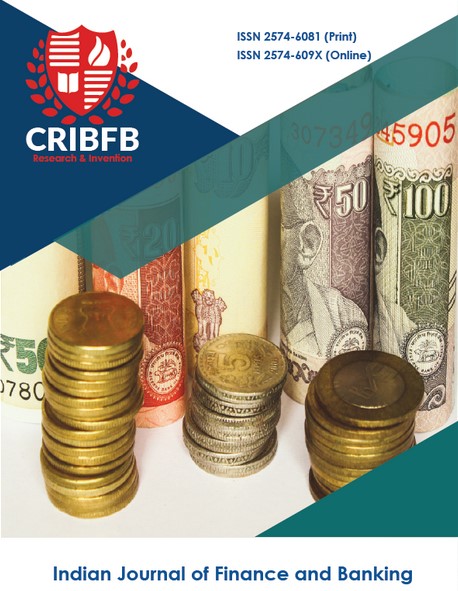THE MOMENTUM EFFECT: ANOMALY OR ILLUSION
Main Article Content
Abstract
This paper tests the effectiveness of the momentum strategy for different time horizons between April 2013 and March 2020 and its sources in the Tunisian stock market. The findings display that, employing the methodology of Jegadeesh and Titman (1993), momentum strategy for all time horizons are positive and statistically significant. In the explanation section of the momentum effect, it is found that the momentum is not an illustration of the January effect and that both models (Capital Asset Pricing Model and the model of Fama and French (1993)) are unable to fully capture the profit of momentum strategy. However, we find that trading costs in the form of quoted spread eliminate the statistical significance of the momentum return. Therefore, an investor can’t make a profit by exploiting the momentum strategy in the Tunisian context.
Downloads
Article Details
Section
How to Cite
References
Antoniou, A., Lam, H.Y.T., & Paudyal, K. (2007). Profitability of momentum strategies in international markets: the role of business cycle variables and behavioral biases. Journal of Banking and Finance, 31, 955–972.
Boujelbene, M.A., Boujelbene, Y., & Bouri, A. (2008). Momentum profits and trading costs. Economic and Management E+M,2, 73-87.
Boussaidi, R., & Dridi, G. (2020). The momentum effect in the Tunisian stock market: risk hypothesis vs. under-reaction hypothesis. Borsa Istanbul Review, 20(2), 178-195.
Cleary, S., & Inglis, M. (1998). Momentum in Canadian stock returns. Canadian Journal of Administrative Sciences, 15(3), 279-291.
Chordia, T., & Shivakumar, L. (2006).Earnings and price momentum. Journal of Financial Economics, 80, 627-656.
Doukas, J. A., & McKnight, P. J. (2005). European momentum strategies, information diffusion, and investor conservatism. European Financial Management, 11(3), 313-338.
Fama, E.F., & French, K.R. (1993).Common risk factors in the returns on stocks and bonds. Journal of Financial Economics, 33(1), 3-56.
Fan, S., Opsal, S., & Yu, L. (2015). Equity anomalies and idiosyncratic risk around the world. Multinational Finance Journal, 19(1), 33-75.
Galariotis, E.C. (2010). What should we know about momentum investing? The case of the Australian Security Exchange. Pacific-Basin Finance Journal, 18(4), 369-389.
Geczy, C., & Samonov, M. (2016). Two centuries of price-return momentum. Financial Analysts Journal, 72(5), 32-56.
Glaser, M., & Weber, M. (2003). Momentum and turnover: Evidence from the German Stock market. Schmalenbach Business Review, 55, 108-135.
Hou, T., & McKnight, P.J. (2004).An explication of momentum in Canadian stocks.Canadian journal of administrative Sciences, 21, 334-343.
Jegadeesh, N., & Titman, S. (1993). Returns to buying winners and selling losers: implications for stock market efficiency. Journal of Finance, 48 (1), 65-91.
Jegadeesh, N., & Titman, S. (2001). Profitability of momentum strategies: An evaluation of alternative explanations. Journal of Finance, 56 (2), 699-720.
Ji, X., Martin, J.S., & Yao, Y. (2017). Macroeconomic risk and seasonality in momentum profits.Journal of Financial Markets, 36, 76-90.
Khosroazad, N., & Chitsazan, H. (2016). Does book to market ratio matter in profitability of momentum investment strategy in Tehran stock exchange? International Journal of Economy, Management and Social Sciences, 5(2), 23-27.
Lesmond, D. A., Schill, M. J., & Zhou, C. (2004). The illusory nature of momentum profits. Journal of Financial Economics, 71, 349 - 380.
Rastogi, N., Chaturvedula, C., & Bang, N.P. (2009).Momentum and overreaction in Indian capital markets.International Research Journal of Finance and Economics, 32, 83-92.
Rouwenhorst, K.G. (1998). International momentum strategies. Journal of Finance, 53(1), 267-284.
Rouwenhorst, K.G. (1999). Local return factors and turnover in emerging markets.Journal of Finance, 54(4), 1439-1464.
Sehgal, S., & Balakrishnan, I. (2008). Rational Sources of Momentum Profits: Evidence from the Indian Equity Market. ICFAI Journal of Applied Finance, 14(1), 5-40.
Zoghlami, F. (2011). Momentum in the Tunisian stocks returns: Identification of some risk factors. Journal of Applied Finance and Banking, 1(2), 207-229.




